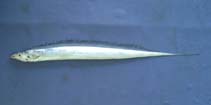
|
Lepturacanthus savala (Cuvier, 1829) Savalai hairtail |

|
|
photo by
Osmany, H.B. |
| Family: | Trichiuridae (Cutlassfishes), subfamily: Trichiurinae | |||
| Max. size: | 100 cm SL (male/unsexed) | |||
| Environment: | benthopelagic; brackish; marine; depth range 0 - 100 m | |||
| Distribution: | Indo-West Pacific: India and Sri Lanka to Southeast Asia, north to China, and south to New Guinea and northern Australia. | |||
| Diagnosis: | Dorsal spines (total): 3-4; Dorsal soft rays (total): 110-120. Pelvic and caudal fins absent; anal fin reduced to spinules (about 75). Lateral line running nearer the ventral than the dorsal contour of the body. Color is steely blue with metallic reflections; the tapering part white. The margin of the anus pale; usually the margin of the caudal-fin membrane white; tip of both jaws black; the inside of the opercle and the anterior part of the shoulder girdle, pale black. | |||
| Biology: | Inhabits coastal waters and often comes near the surface at night. Feeds on a variety of small fishes and crustaceans (chiefly on prawns and species of Setippina, Anchoviella, Harpodon, Trichiurus etc. in Hooghly estuaries in India). Caught mainly with shore seines, bagnets and coastal bottom trawls in Asian countries. Marketed fresh and iced as well as dried salted. | |||
| IUCN Red List Status: | Not Evaluated (N.E.) Ref. (130435) | |||
| Threat to humans: | harmless | |||